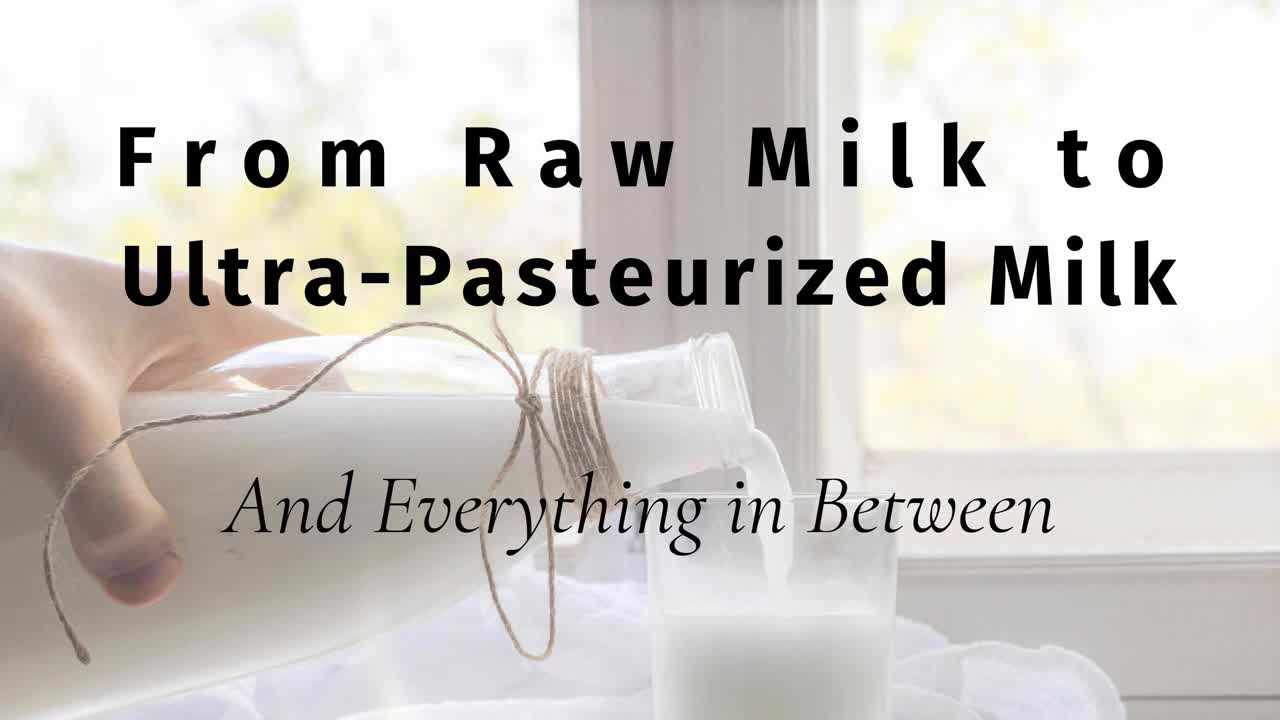Premium Only Content

From Raw Milk to Ultra-Pasteurized Milk
Raw Milk to Ultra-Pasteurized Milk and everything in between is the topic of today’s podcast. I’m going to talk all about all sorts of milk and milk products. I’ll give a brief definition of each one along with various commentary about development and uses of these nutrient-dense sources of food.
But first, I want to welcome each and every new listener. I hope you enjoy this content and share it with your friends and family. And as always, a heart-felt welcome back to the veteran homestead-loving regulars who stop by the FarmCast every week. I appreciate you all so much. There is no show without you and your input.
Exciting news is happening at the homestead. Are you ready? Let’s get to it.
Today’s Show
• Homestead Life Updates
• From Raw Milk to Ultra-Pasteurized Milk, and everything in between
• Recipe – Crème Fraîche
Homestead Life Updates
It seems as though we skipped from summer to winter with only a few days of fall in between. Oh well, perhaps it will be warmer in December. Sometimes it is. When I first moved to Virginia, we experienced winters that had about 5 days of weather that would get down into the 20’s at night. Occasionally, we would have a night where it slipped into the teens. The past couple of years we have had some really cold winters with many days in the low-teens and even single digits at night with highs in the 20’s. This year, this fall, we have already had nights in the 20’s if you can believe it. Who knows what the winter will hold? Perhaps it will actually be warmer.
The Cows
Any day now we will have a new calf. Cloud is showing signs of the last stages. She moves very slowly and with difficulty as the calf has dropped down quite a bit. She waddles. Her udder is larger than Violet’s at this late point in her lactation cycle. Violet’s udder was larger at the onset of her lactation. She is at the end of her lactation cycle and producing much less milk at this point.
The Quail
The quail are doing well with the cold. Unfortunately, we lost 4 of the 6 to a predator. It happens. There were signs of an animal laying underneath the top cage. There are two sets of cages one on top of the other. Under the top cage is a slanted board with plastic so we can scrape off the manure. It looks like that plan will have to be modified in some way if predators are going to reach up from underneath and snag the birds. Anyway, the remaining two were put in with the main flocks on the lower level and all are doing well. Their waste goes straight through the bottom of the cage to the ground. There is extra board below them so no way to get up underneath that bottom set of cages. They are well off of the ground.
The Sheep, Goats, and Donkeys
All are doing well. I don’t remember if I mentioned that we lost a couple of lambs to predators. The rest are doing fine. The donkeys have been really good at keeping the predators away from the sheep and lambs. I’m not sure what happened there.
The Creamery
The inner walls are complete. Scott is going to take a break from all that block work and start back on fencing. The work is never done. While fixing fence he will also be creating firewood. We have been using standard heating during the unseasonably cold fall weather. But soon we will have wood to use in the wood stove for heating. It will be so warm and toasty in here. For the past week or so I’ve been closing myself into the office and running the small heater that we have in there to keep warm while the rest of the house is about 68 degrees. That’s really cold for me. It probably wouldn’t be so bad if I just surrendered and put some socks on to keep my feet warm. I don’t know about you, but when my feet and hands get cold the rest of me feels like it is freezing and will never be warm again.
Enough about that. Let’s get on to today’s topic.
From Raw Milk to Ultra-Pasteurized Milk
And everything in between
Dairy products have long been favored for their contributions to the human diet. Cave paintings made in the Libyan Sahara in 5000 BC show people milking animals and making cheese. Some research indicates that goats and sheep provided the first dairy products for humans. Later, cows supplied dairy products for much of the world.
Before refrigeration was invented milk spoiled rapidly. However, we humans quickly learned to preserve milk by making butter, ghee, cheese and other fermented products. By the first century A.D., the Romans were master cheesemakers, even using cheese presses to aid in separating the whey from the curd. Over the years, people have experimented with many variations in milk—and cheesemaking processes. (See my podcast on The History of Cheese. Link in the show notes.) As a result, a great diversity of fermented milk and cheese products are available today. I gave the basics of cheese styles in a previous podcast. In a future podcast, I’ll go over more details of some common cheeses you might find in your local supermarket and what distinguishes them one from another. I’ll include information on our lovely cheeses as well.
Milk
Milk is a dairy product that is valued as a nutritious beverage, and ingredient in cooking, and the foundation of other dairy products, including butter, cheese, and yogurt.
The composition of milk varies, depending on the type of animal, the breed, the animal’s diet, the season, and even the time of day the animal is milked. Unless I mention it as otherwise, milk in this podcast is about cow’s milk. Cow’s milk from a grocery in the US is composed primarily of water (88%). It contains about 3.5% milk fat and about 8.5% milk solids in the form of proteins (primarily casein), lactose (milk sugar), minerals, and vitamins. Milk provides a rich source of calcium, as well as vitamins A, D, E, K, C, and B. Commercial milk is fortified with additional vitamin D. To replace the vitamin A drawn off with the removal of milk fat, low fat and skim milk products are fortified with vitamin A.
Casein is the primary protein in milk. It causes milk to clump and curdle in the presence of acid, too much salt, or too-high heat. When milk is heated, a skin can form on top. The skin is actually coagulated protein and fat. Milk also can coagulate and then burn on the bottom of a pan if you are not careful when heating it. Continuous stirring, heavy cookware, moderate heat, and minimal cook times help limit coagulation.
Milk Processing Methods
Milk, like all food products, provides a favorable host for the growth of bacteria, some of which can cause serious illness. Because of this, almost all milk is treated with some kind of pasteurization to kill bacteria and increase its shelf life.
Pasteurization
In the 1860s, French chemist Louis Pasteur discovered a way to use heat to prevent spoilage of beer and wine without destroying their flavor. Pasteurization applies the same theory to the treatment of milk. Personally, I think pasteurization does destroy the flavor of milk. See my previous podcast, Benefits of Raw Milk, for more on that. The law requires all Grade A milk to be pasteurized. In fact, nearly all milk sold commercially in Western countries is pasteurized. The most common pasteurization technique heats milk to 161°F for 15 seconds and then rapidly cools the milk to 45°F. Pasteurization is used to kill bacteria and extends the keeping qualities of milk by killing naturally occurring enzymes that cause milk to sour and ferment. Unlike raw milk, pasteurized milk does not become sour and naturally ferment into other products. Pasteurized milk, properly refrigerated, keeps for about a week before it rots and becomes completely unusable even for cooking.
Ultra-pasteurization
Ultra-pasteurization is often used to extend the shelf life of cream. Ultra-pasteurization subjects dairy products to much higher temperatures for shorter periods, destroying nearly all bacteria. Unopened, refrigerated ultra-pasteurized milk and cream stays fresh for 2 to 3 months. Once opened, the product will stay fresh about as long as conventionally pasteurized milk products.
Ultra High Temperature Processing
Ultra high temperature (UHT) processing combines the process of ultra-pasteurization with specialized packaging. Holding the milk for 2 to 6 seconds at 280°F to 300°F sterilizes it. Hermetically sealed sterile containers block out bacteria, gases, and light. Unopened UHT milk can safely be stored without refrigeration for up to three months. After it is opened, you handle UHT milk in the same way as conventionally pasteurized milk products. If you are making your own cheese at home, never use UHT milk. It has been damaged too badly to be useful in making cheese, yogurt and so on.
Homogenization
In raw milk, the milk fat particles float to the top, creating a layer of cream sometimes called the “cream line.” This happens because the fat globules, which are lighter than the surrounding water, are too large to stay suspended in the emulsion. To prevent the separation of milk fat, most commercially sold milk is homogenized. Homogenization breaks down fat globules by forcing the warm milk through a very fine nozzle. This process reduces the fat particles to 1/10 their original size, thus allowing the milk fat to stay suspended in liquid.
Removal of Milk Fat
Removing milk fat fills the demand for additional variety in milk and cream products. To remove milk fat, milk is processed in a separator, a type of centrifuge. The milk spins at high speeds, causing the lighter milk to collect at the outer wall of the separator, while the denser cream collects in the center, where it is piped off. Modern separators can produce a range of milk products from whole milk to low-fat or reduced fat to skim.
Description of Milk Products
Liquid Whole Milk
Whole milk contains not less than 3.25% milk fat and 8.25% milk solids. Vitamins A and D are optional additions, as our flavoring ingredients, such as chocolate.
Liquid Low-Fat Or Reduced-Fat Milk
Milk with some fat removed will contain between 0.5% and 2% milk fat and not less than 8.25% milk solids. Common low-fat milk includes 1% milk; reduced fat milk includes 2% milk. Low-fat and reduced-fat milks must contain added vitamin A and vitamin D is optional.
Liquid Skim Milk
Skim milk is also called fat-free or nonfat milk. All or most of the fat has been removed. Skim milk is less than 0.5% milk fat and not less than 8.25% milk solids. Vitamin A must be added. Vitamin D is optional.
Evaporated Milk
Canned concentrated milk, called evaporated milk, is formed by evaporating about 60% of the water from whole or skim milk. It has a cooked flavor and darker color than regular milk. Evaporated or condensed whole milk contains at least twice the milk fat and solids of whole milk – 6.5% milk fat and 16.5% milk solids.
Sweetened Condensed Milk
Sweetened condensed milk is whole milk with 60% of its water removed and a large quantity of sugar added. It’s pasteurized and usually sold in cans. Sweetened condensed milk is not an acceptable substitute for whole or evaporated milk because of the added sugar.
Dry Milk Powder
Milk with nearly all moisture removed is called powered milk or dry milk. It is usually made from skim milk, although whole milk powder is also available. Dry milk can be used to enrich baked goods or it can be reconstituted in water.
Varieties of Cream
Half-And-Half
A mixture of milk and cream is labeled half-and-half. It contains at least 10.5% but no more than 18% milk fat. We use it in coffee. Some use it in cereal. It is often used in baking and as an enrichment to other foods.
Light Cream
The next step up in thickness of cream is light cream. Also called coffee cream or table cream. It contains between 18% and 30% milk fat. It is also used in baking and as an enrichment for other foods. The higher you go in cream content the higher you go in calories. So, keep that in mind when deciding whether to use it in coffee or cereal.
Light Whipping Cream
Light whipping cream, also just called whipping cream, contains between 30% and 36% milk fat. It can be whipped or used to make sauces, ice cream, and other desserts.
Heavy Whipping Cream
Heavy whipping cream (HWC for the keto/carnivore crowds) is also called heavy cream. It contains at least 36% milk fat. As you would expect, it whips well and is used as a topping for desserts. It is also used for thickening, and as enrichment for sauces and various desserts.
Other Milks
All female mammals produce milk to feed their young, so it is not surprising that humans over the years have taken and continue to take milk from a variety of species. People in parts of Africa and the Middle East prize camel milk. Some groups in northern Scandinavia and Russia milk reindeer. It is said that Genghis Khan and the Mongolians conquered vast lands living on meat, blood and mare’s milk. Although cow’s milk is the most common today, people in many parts of the world use milk from sheep, water buffalo, and goats.
Sheep’s Milk
Sheep’s milk is higher in fat (6.5%) and protein (5.8%) content than cow’s milk. People drink sheep’s milk and make yogurt and cheese from it. True Roquefort cheese is made from sheep’s milk. Feta is traditionally made with sheep’s milk or a mixture of sheep’s and goat’s milk.
Water Buffalo’s Milk
Water buffalo’s milk has a high percentage of fat (7.2%) and a protein count comparable to that of cow’s milk (3.8%). Provolone cheese was first made with water buffalo’s milk. Today Italy prides itself on making the highest quality mozzarella cheese from water buffalo milk.
Goat’s Milk
Goat’s milk contains a similar amount of fat and protein as cow’s milk, but the smaller fat globules in goat’s milk stay suspended, making homogenization unnecessary. Cheese made from goat’s milk is referred to as chèvre (the French word for “goat”) and is noted for its sharp, tangy flavor.
Cultured Products
Fermented dairy products, also called cultured dairy products, are the result of adding a starter bacterial culture to fluid dairy products. Under the right temperature conditions, these lactic acid producing bacteria reproduce rapidly, causing milk or cream to ferment. The fermentation process gives dairy products a tangy flavor and thicker consistency.
Buttermilk, yogurt, sour cream, and crème fraîche are the most common cultured dairy products.
Buttermilk
Traditionally, buttermilk was a byproduct of the butter-making process. Today people make buttermilk by introducing starter cultures from bacterial strains into skim or low-fat milk and then holding the milk at a controlled temperature for 12 to 14 hours. Buttermilk adds a distinctive, tart taste to baked goods and other dishes. Some people enjoy buttermilk as a beverage.
Yogurt
Yogurt adds a tangy flavor to sauces and other dishes and provides a low-fat substitute for sour cream. Yogurt is made by the same process as that for buttermilk but with different bacterial strains. This causes the milk to ferment and coagulate into a custard like consistency. Some yogurt contains live active bacteria. Medical research shows that yogurt with live active cultures helps the body produce lactase, an enzyme that breaks down lactose. This aids digestion, especially in those who have difficulty digesting milk products because of lactose intolerance. Research also suggests that eating yogurt with live active culture speeds recovery from some forms of intestinal illness.
Sour Cream
Sour cream is made using the same process and bacteria as those for buttermilk, but it typically uses cream with 18% milk fat as its base. Sour cream is smooth, thick, and tangy.
Crème Fraîche
Commercial crème fraîche is cultured, heavy cream that resembles a thinner, richer version of sour cream. Widely available in Europe, crème fraîche is expensive in the United States. Better to make it yourself with this easy recipe.
Crème Fraîche Recipe
Use it anywhere you would use sour cream. Because sour cream has less fat but more protein, simmering or boiling it will result in curdling. Crème fraîche is a better choice for sauces or soups.
In France, crème fraîche was traditionally made from unpasteurized cream that naturally contained the right bacteria to thicken it. Since our cream is pasteurized here in the US, this crème fraîche is made by adding a fermenting agent with bacteria to heavy cream.
What You Need
• 2 cups heavy cream
• 3 tablespoons cultured buttermilk
What To Do
1. In a glass jar, combine the buttermilk with the heavy cream.
2. Cover the jar tightly with cheesecloth or other breathable material. Let sit at room temperature (70 to 75 degrees) for 24 hours.
3. Remove cloth, stir. It will be thick but will get thicker. Screw on a lid, and refrigerate for another 24 hours before using.
Final Thoughts
Whew that was a lot of information about milk and milk products packed into one podcast. You might want to listen to that again and take notes. Or hop over to peacefulheartfarm.com and click or tap “Podcast” on the menu to read and bookmark the show notes.
The homestead is perking along well. I’m so excited about the impending arrival of a newborn calf. Even though she wasn’t planned, life is precious to us and we will welcome this calf with open arms. We will figure out what to do with her. I’m sure it’s going to be a heifer. Ok, I’m not really sure. We don’t do ultrasounds to determine the sex of our calves, but it’s great to say out loud what I want.
I hope you’ll experiment with brewing up some homemade crème fraîche. Remember, don’t use ultra-high temperature pasteurized cream. It simply will not produce the product you are looking to create.
If you enjoyed this podcast, please go to Apple Podcasts, SUBSCRIBE and give me a 5-star rating and review. And the best way to help out this show is to share it with any friends or family who might be interested in this type of content.
As always, I’m here to help you “taste the traditional touch.”
Thank you so much for stopping by the homestead and until next time, may God fill your life with grace and peace.
References
• The History of Cheese
• Benefits of Raw Milk Podcast
Recipe Link
Crème Fraîche
To share your thoughts:
• Leave a comment on our Facebook Page
• Share this show on Twitter, Facebook and Instagram
To help the show:
• PLEASE LEAVE A REVIEW for Peaceful Heart FarmCast on Apple Podcasts.
• Subscribe on iTunes, Stitcher Radio, Google Play Music, TuneIn or Spotify
• Donate on Patreon
Website
www.peacefulheartfarm.com
Patreon
www.patreon.com/peacefulheartfarm
Facebook
www.facebook.com/peacefulheartfarm
Instagram
www.instagram.com/peacefulheartfarm/
-
 LIVE
LIVE
TimcastIRL
39 minutes agoTrump Just REVOKED Legal Status Of 530,000 Migrants, Deportations NOW w/ Alex Stein | Timcast IRL
20,664 watching -
 LIVE
LIVE
Shield_PR_Gaming
5 hours agoSome Gray Zone Warfare with Followers!
224 watching -
 31:38
31:38
Michael Franzese
1 hour agoTony Accardo: The Genius That Built Chicago’s Most Powerful Empire
149 -
 45:40
45:40
BonginoReport
3 hours agoCritics Give Disney’s Feminist “Snow White” a Rotten Apple (Ep.10) - Nightly Scroll w Hayley 03/21/2025
51K91 -
 1:47:40
1:47:40
Kim Iversen
5 hours agoWhy Did Sarah Ashton-Cirillo Help Jail Gonzalo Lira? His Side of The Story
55.5K95 -
 LIVE
LIVE
Dr Disrespect
8 hours ago🔴LIVE - DR DISRESPECT - TRIPLE THREAT CHALLENGE - WZ, PUBG, FORTNITE
2,203 watching -
 12:23
12:23
Adam Does Movies
3 hours agoSnow White (2025) Movie Review - Disney Does It Again!
1244 -
 1:33:43
1:33:43
Tucker Carlson
2 hours agoSteve Witkoff’s Critical Role in Negotiating Global Peace, and the Warmongers Trying to Stop Him
36.7K50 -
 15:56
15:56
T-SPLY
6 hours agoDemocrats Are Now Lying About The Department Of Education Shutdown
51.9K38 -
 LIVE
LIVE
Edge of Wonder
5 hours agoJFK Files Update: The Secret $100K Bounty
408 watching